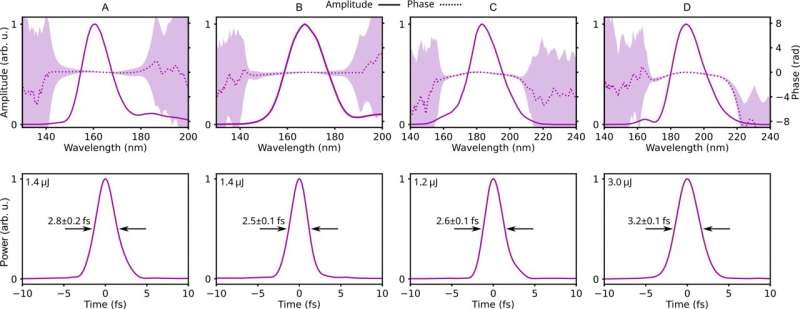
Electron FROG apparatus. a. measured spectra of pulses tuned across the VUV, b. and c. electron FROG traces of pulses centered at 180 and 170 nm, respectively. b. shows the imprint of auto-ionizing states of xenon while c. exhibits a double-peak structure due to spin-orbit splitting. Credit: MBI | José Andrade
A team of researchers at the Max Born Institute have managed to fully characterize few-femtosecond-long light pulses tunable in the vacuum ultraviolet. These results unlock the possibility for studying valence electron dynamics of many materials in the VUV.
The research is published in the journal Nature Photonics.
Few-femtosecond long pulses tunable across the ultraviolet (UV) are a holy grail of contemporary laser science. As most of the materials have electronic resonances in the deep- and vacuum-UV (VUV), such pulses enable the study of valence electron dynamics at an unprecedented temporal resolution.
However, due to the Kramers-Kronig relation, the vicinity of resonances intrinsically invokes high material dispersion, which makes the handling and measurement of such pulses extremely difficult.
John C. Travers at Heriot-Watt University, UK, has developed a technique which is ideal for the generation of µJ-level tunable few-fs UV pulses showing a wide tunability down to 110 nm. It uses resonant dispersive wave (RDW) emission following soliton self-compression in waveguides.
This technique requires very high quality hollow waveguides, which became first available by stretching flexible capillaries, an invention of the last author of the current MBI work together with Peter Simon at the Institut für Nanophotonik Göttingen e.V., Germany.
Thanks to the continuous development of Travers’s group, the RDW technique is now used for studies in a wide spectral range down to the deep-UV (~230 nm). However, shorter wavelengths of the VUV (100–200 nm) have not been explored yet, due to the immense technical difficulties connected to the high absorption and excessive dispersion of the materials in this regime.

Measured VUV pulses. Top row: measured spectra with retrieved phase, bottom row: retrieved pulse shapes. Credit: MBI | José Andrade
Now scientists at the Max Born Institute, Berlin, Germany have successfully extended the usability of the RDW technique to the VUV spectral range. They fully characterized few-fs pulses tuned between 160 and 190 nm by a technique that they call electron FROG.
It is a variant of frequency-resolved optical gating (FROG) using two-photon ionization of noble gases as the nonlinearity. During the measurement, the kinetic energy spectrum of the photoelectrons is recorded as a function of the delay between two pulse replicas ionizing the gas target.
The recorded two-dimensional spectrograms contain information on the pulse shape that can be extracted by using an iterative phase-retrieval algorithm. However, unlike standard all-optical FROG traces, the electron FROG traces not only depend on the pulse shape, but also contain the fingerprint of the atomic structure of the target gas.
This required the development of a special phase retrieval code based on a differential evolution algorithm. The measurements were validated by a series of checks including comparison of the results with ab initio quantum mechanical (TDSE) calculations. The in situ measurements reveal that the RDW-generated VUV pulses have a duration of 2–3 fs, in accordance with former predictions based on simulations.
The electron FROG apparatus was also used for pump-probe measurements on a series of small organic molecules, such as ethylene. These measurements, carried out with unprecedented temporal resolution, shed new light on the early-time relaxation dynamics after photo-excitation.
Currently, the measured data are being analyzed and compared with molecular dynamical simulations.
More information:
José R. C. Andrade et al, Temporal characterization of tunable few-cycle vacuum ultraviolet pulses, Nature Photonics (2025). DOI: 10.1038/s41566-025-01770-6
Provided by
Max Born Institute for Nonlinear Optics and Short Pulse Spectroscopy
Citation:
Ultrafast VUV pulses fully characterized for probing valence electron dynamics (2025, November 7)
retrieved 7 November 2025
from https://phys.org/news/2025-11-ultrafast-vuv-pulses-fully-characterized.html
This document is subject to copyright. Apart from any fair dealing for the purpose of private study or research, no
part may be reproduced without the written permission. The content is provided for information purposes only.
